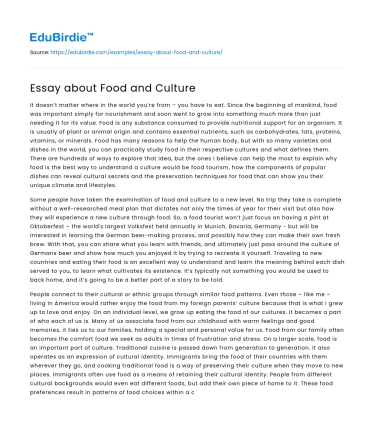It doesn’t matter where in the world you’re from – you have to eat. Since the beginning of mankind, food was important simply for nourishment and soon went to grow into something much more than just needing it for its value. Food is any substance consumed to provide nutritional support for an organism. It is usually of plant or animal origin and contains essential nutrients, such as carbohydrates, fats, proteins, vitamins, or minerals. Food has many reasons to help the human body, but with so many varieties and dishes in the world, you can practically study food in their respective cultures and what defines them. There are hundreds of ways to explore that idea, but the ones I believe can help the most to explain why food is the best way to understand a culture would be food tourism, how the components of popular dishes can reveal cultural secrets and the preservation techniques for food that can show you their unique climate and lifestyles.
Some people have taken the examination of food and culture to a new level. No trip they take is complete without a well-researched meal plan that dictates not only the times of year for their visit but also how they will experience a new culture through food. So, a food tourist won’t just focus on having a pint at Oktoberfest – the world's largest Volksfest held annually in Munich, Bavaria, Germany - but will be interested in learning the German beer-making process, and possibly how they can make their own fresh brew. With that, you can share what you learn with friends, and ultimately just pass around the culture of Germans beer and show how much you enjoyed it by trying to recreate it yourself. Traveling to new countries and eating their food is an excellent way to understand and learn the meaning behind each dish served to you, to learn what cultivates its existence. It’s typically not something you would be used to back home, and it’s going to be a better part of a story to be told.
Save your time!
We can take care of your essay
- Proper editing and formatting
- Free revision, title page, and bibliography
- Flexible prices and money-back guarantee
People connect to their cultural or ethnic groups through similar food patterns. Even those – like me – living in America would rather enjoy the food from my foreign parents’ culture because that is what I grew up to love and enjoy. On an individual level, we grow up eating the food of our cultures. It becomes a part of who each of us is. Many of us associate food from our childhood with warm feelings and good memories, it ties us to our families, holding a special and personal value for us. Food from our family often becomes the comfort food we seek as adults in times of frustration and stress. On a larger scale, food is an important part of culture. Traditional cuisine is passed down from generation to generation. It also operates as an expression of cultural identity. Immigrants bring the food of their countries with them wherever they go, and cooking traditional food is a way of preserving their culture when they move to new places. Immigrants often use food as a means of retaining their cultural identity. People from different cultural backgrounds would even eat different foods, but add their own piece of home to it. These food preferences result in patterns of food choices within a cultural or regional group. For example, my Spanish mother enjoys American food but with more spice to match what she was typically used to growing up outside of America.
Food preservation techniques are unique to climates and lifestyles. Have you ever wondered why the process to preserve meat varies so differently around the world? It has to do with the local resources, needs, and climates. In Morocco, khlea is a dish composed of dried beef preserved in spices and then packed in animal fat. When preserved correctly, it’s still good for two years when stored at room temperature. That makes a lot of sense in Morocco, where the country historically has had a strong nomadic population, desert landscape, and extremely warm, dry temperatures. The Moroccans used their surroundings to better use them and stayed alive and well.
“Tell me what you eat, and I’ll tell you who you are”, – Jean Anthelme Brillat-Savarin. Food plays an integral role in our lives, and rightfully so: the food we eat is intricately intertwined with our culture. You can learn a lot about a particular culture by exploring their food. In fact, it may be difficult to fully define a culture without a nod to its cuisine. Certain foods represent certain cultures. Some cultures wouldn’t even eat certain food because of tradition. Some cultures find it disrespectful to finish one’s plate, while others find it disrespectful to not have more than one. And other cultures wouldn’t even let you try and finish by continuing to add food to your plate. Every culture, of course, is different and shows its different values of hospitality through the universal love of food. And with that, it can be easily assured that there are many ways to learn and understand a culture, but food has to be the most important way to recognize a culture.






 Stuck on your essay?
Stuck on your essay?

